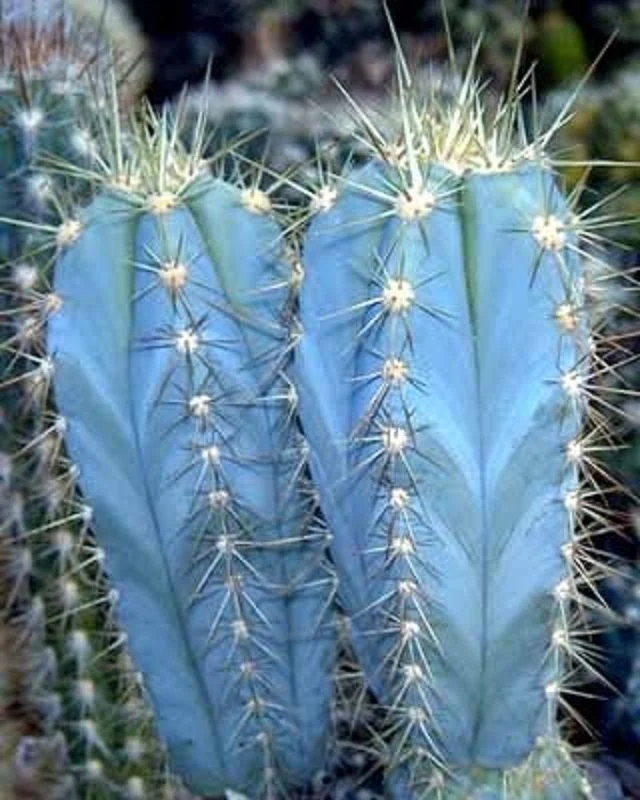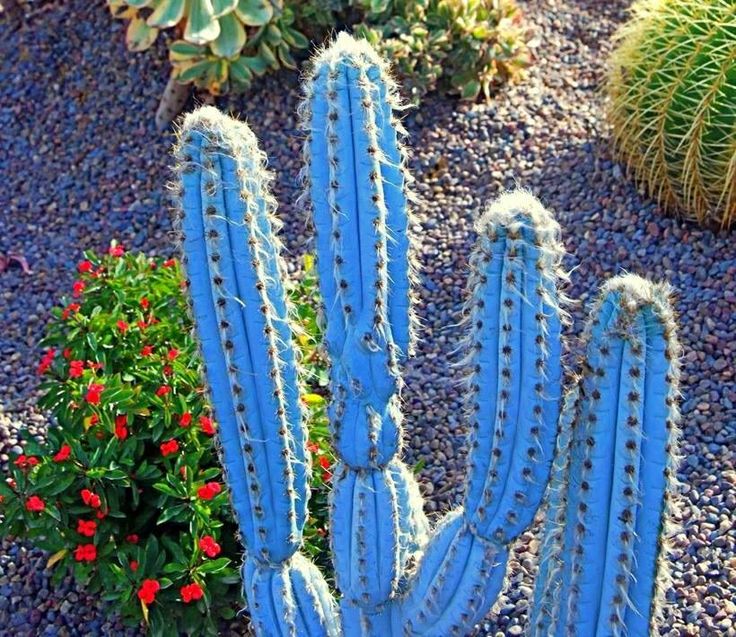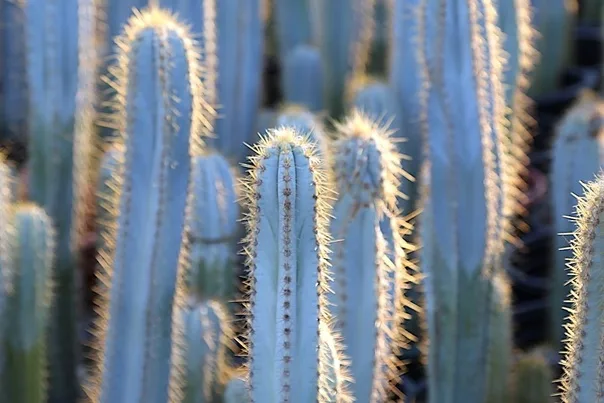index
Presentation
The Pilosocereus pachycladus, known as the Blue Cactus, is a fascinating species that captivates lovers of succulents. Originally from Brazil, this cactus has cylindrical blue-green stems adorned with spaced spines. Its unique beauty and resistance make it a popular choice for cactus collectors and gardeners all over the world.
The Meaning of the Blue Cactus
The Blue Cactus goes beyond its stunning aesthetics, carrying with it symbolic meanings. Its bluish color represents tranquility and serenity, adding a calming atmosphere to any space where it is grown. In addition, its resilient nature symbolizes strength and adaptation, highlighting the beauty that can flourish even in adverse conditions. This cactus is not only a visually impressive addition to your garden, but also carries with it a message of endurance and calm.
| Common Name | Blue Cactus |
|---|---|
| Botanical Name | Pilosocereus pachycladus |
| Family | Cactaceae |
| Type of Plant | Cactus |
| Adult size | Varies, generally from medium to large |
| Solar Exhibition | Full sun |
| Soil Type | Well drained |
| Soil pH | Slightly acidic to neutral |
| Flowering Season | Spring and summer |
| Color of Flowers | White to yellow |
| Native Area | Brazil |
| Toxicity | Not reported, but caution is advised |

Understanding the Care of the Blue Cactus
Light
For the lush flowering of the Blue Cactus, light plays a vital role. Position it in a place with full sun, ensuring at least 6 hours of direct sunlight a day. This condition promotes the healthy development and vibrant color of the stems.
Soil
The soil is the basis of success for growing Pilosocereus pachycladus. Opt for a well-drained substrate, rich in organic matter. The drainage capacity prevents excessive accumulation of water, preventing problems such as root rot.
Water
Water the Blue Cactus sparingly. Allow the soil to dry out completely between waterings, avoiding waterlogging. In winter, reduce the frequency. Remember, over-watering is more harmful than under-watering.
Temperature and HumidityTemperature and Humidity
Originally from Brazil, the Blue Cactus appreciates warm conditions. Keep the temperature between 20°C and 30°C. Low humidity is well tolerated, simulating its native habitat.
Fertilization
Fertilizing is essential to nourish the Blue Cactus. Use a balanced fertilizer during spring and summer. Reduce the frequency in fall and winter. Follow the manufacturer’s instructions to avoid overdoing it.
By following these guidelines, you’ll be providing your Blue Cactus with the ideal environment to thrive, guaranteeing a spectacle of colors and shapes in your garden.
How to Make Blue Cactus Cuttings
Producing seedlings of the Blue Cactus is an exciting and affordable process. Start by selecting a healthy, mature stem. With a sterilized knife, cut the stem into a segment of approximately 10 cm. Leave the cutting to heal for a few days, allowing the base to dry out. Plant the cutting in well-drained soil and wait patiently for the roots to develop. This is the starting point for a new growing journey.

How to Plant the Blue Cactus
The timing of planting the Pilosocereus pachycladus is crucial for its healthy establishment. Choose a pot or planting site with good drainage. Place the seedling in the soil, burying it lightly. Avoid watering immediately; allow the seedling to adapt to its new environment. After a few days, resume watering in moderation. This simple process marks the beginning of a new chapter in the life of your Blue Cactus.
Most Common Pests and Diseases
When caring for the Blue Cactus, be aware of possible adversities. Some common pests and diseases include:
- Mites: Small insects that can cause spots on leaves.
- Bugs: White or grayish masses usually present on the joints of the cactus.
- Root rot: A problem resulting from waterlogged soil, leading to root rot.
- Oidium: White powdery spots on the leaves.
Common Problems and Their Solutions
Mites:
- Solution: Rinse the leaves with water and use neem oil.
Bugs:
- Solution: Remove manually or use neem oil.
Root rot:
- Solution: Improve soil drainage and avoid overwatering.
Mildew:
- Solution: Treat with sulfur or baking soda.
Keeping an eye out for early signs, such as changes in the color or texture of the stems, allows you to intervene quickly, keeping your Blue Cactus healthy and vibrant.

Curiosities and MythsCuriosities and Myths
In this section, we delve into the intriguing universe of the Blue Cactus (Pilosocereus pachycladus), uncovering fascinating curiosities and debunking myths surrounding this extraordinary species.
Curiosities
1. Single color:
The bluish hue of the Blue Cactus’s stems is not just aesthetic. It is the result of the presence of protective waxes that help minimize water loss, adapting to the arid conditions of its natural habitat.
2. Extreme Resistance:
This species is adapted to survive in harsh environments. Its spines not only provide protection against herbivores, but also help to reduce the temperature of the stems, preventing them from overheating.
3. Imposing longevity:
The Blue Cactus can live for several decades, being a silent witness to the changes around it. Its longevity highlights its incredible ability to resist and thrive in challenging conditions.
Myths Debunked
1. All Blue Cacti Are the Same:
Myth Debunked: Different species of cacti have different shades of blue. The Blue Cactus (Pilosocereus pachycladus) stands out for its unique coloring, but variations can occur.
2. Extreme Resistance Means Little Care:
Myth Debunked: Despite its resilience, the Blue Cactus still requires proper care, including moderate watering, well-drained soil and adequate sun exposure to flourish fully.
By exploring these curiosities and demystifying concepts, the journey of cultivating the Blue Cactus becomes not just a gardening practice, but an immersion in its fascinating history and unique characteristics.

ConclusionConclusion
Throughout this guide, we will reveal the secrets and care needed to successfully cultivate the Blue Cactus (Pilosocereus pachycladus). Let’s remember the main points that guarantee the healthy flowering of this magnificent species. Adequate sun exposure, well-drained soil and moderate watering are fundamental to providing the Blue Cactus with the right environment for its vibrant development. Attention to detail, such as pest prevention and rapid intervention in the event of signs of disease, contributes to the longevity and vitality of this unique plant.
In the midst of revealing curiosities and debunking myths, we realized that the Blue Cactus is more than just an ornamental plant. Its resilience symbolizes the ability to thrive in challenging conditions, and its unique beauty adds an exotic touch to any space. By growing the Blue Cactus, we not only create a stunning garden, but we also connect to a narrative of resilience and admiration for the exuberance of nature. May each dedicated care be a tribute to the enduring charm of the Blue Cactus in our lives.
Frequently Asked Questions
How do cacti become colorful?
The vibrant color of cacti, including the Blue Cactus, is related to the presence of special pigments called carotenoids. These pigments, together with other compounds, give shades ranging from green to blue and even purple. The intensity of the colors can be influenced by environmental factors such as sun exposure and temperature.
How long does the blue cactus flower last?
The Blue Cactus flower is short-lived, usually lasting one to two days. This short flowering period is common in many cactus species. The flowering process is highly sensitive to environmental conditions, and the flowers open to attract specific pollinators during this brief interval, contributing to the plant’s reproduction.
Why does the cactus turn blue?
The blue hue of the Blue Cactus is the result of the presence of waxes on the surface of the stems. These waxes play a crucial role in reducing water loss, an evolutionary adaptation to cope with arid environments. The blue color is a response to this protective layer, reflecting light in a unique way and giving the cactus a unique aesthetic in the realm of succulent plants.







